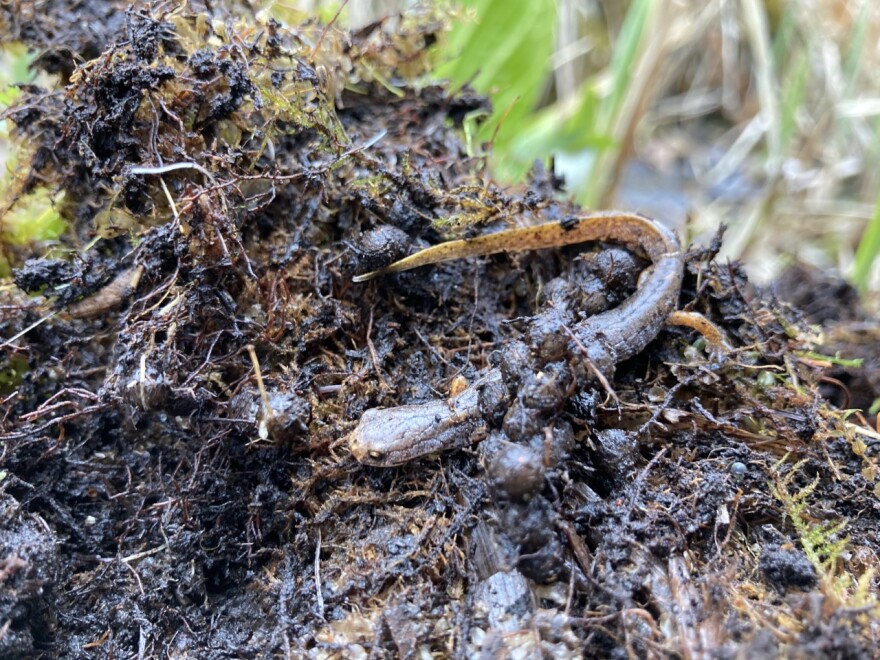The Wisconsin DNR describes salamanders as “the most secretive within the amphibian community” because most go entirely undetected by humans.
Wisconsin is home to six species considered “common," meaning they’re in good supply.
But a seventh species, called the four-toed — a delicate creature with a thick, rounded tail — falls under a cautionary “special concern” status.
So, when two students found the teeny amphibian at UW-Milwaukee’s field station they were ecstatic. It was the first ever identified in Ozaukee county.
The date was October 29, the hour, nearly lunchtime.
Conservation and environmental studies senior Morgan Schmanski says she loved the class, but it was five hours long, so she was ready for a break.

Until she spotted a rock at the base of an uprooted tree that intrigued her; Schmanski loves a good rock.
"It was like right here. I had stopped and everybody was up there already,” Schmanski recalls.
Next to the rock, Schmanski saw what looked like a small tail.
A classmate guessed it belonged to a dead snake, but Schmanski wasn’t convinced. So she turned to another classmate, Joey Cannizzaro
.
“I know that he’s a (herpetology) guy. I asked him, I was like — 'I need your opinion, because I’m pretty sure I found something, but I don’t know what I found,'" Schmanski says.

A biology grad student, Cannizzaro
remembers gently brushing away some soil. It was indeed a four-toed salamander.
“I thought it was a worm because the way the tail was sticking out, but then we uncovered it and I was like this is a very weird looking worm,” Cannizzaro
continues. “It’s Wisconsin’s smallest salamander, I mean, they’re very small.”
Morgan Schmanski says it was about the size of the palm of her hand.
The students' find was published in Herpetological Review.
Their discovery was last October. Now it's May. Cannizzaro says he remains on the lookout for four-toeds, Their bellies are pearly white in color with a sprinking of fine black dots. The rest of their diminutive bodies are complex shades of brown.
“There are very small windows of time in the year where you find them generally. This coming summer you aren’t going to see them at all because it just gets too hot for them and they’ll burrow feet below the earth,” Cannizzaro explains, “The next time to encounter them would probably be in the fall, but again, not as common as the nesting that they’re doing right now.”

Earlier in the day, he and Schmanski found several males beneath moist logs. They even found a nesting female.
“Now they’ve emerged from hibernation,” Cannizzaro
says. Schmanski adds, “They are fertile because they breed in fall.”
Females gravitate to wetlands where patches of dense moss formations create air space between its underside and the water below.
“You stick your hand within that space, you peel it up, so what you find is her guarding her eggs,” he says.

In Cannizzaro's words, the female wraps her cute little body around her eggs to protect them, “and then when they start to hatch, they kind of fall right into the water."
The four-toed salamander isn’t the only natural treasure that’s been found at the field station. Gretchen Meyer is its director.
“So I have a list of vertebrates, I have a bird list, I have a mammal list, I have a herp list which covers snakes, amphibians and turtles. So we added it to the list,” Meyer says.
She would like nothing more than to have research spring from the four-toed discovery; there are no quantitative studies documenting its decline, but Meyer says, “We don’t have the staff to go out and monitor. Now that we know they’re here, maybe someone in the future may decide that they want to study them and look into them in more detail now we know that would be possible."
It won’t be Morgan Schmanski. She’s just figuring out her career path. Joey Cannizzaro is knee-deep in gray tree frog research.
In the meantime, he says preserving areas where diverse plant and animal species live is essential.
“Again, (it's) really important to preserve both these kinds of habitat because you have this upland habitat — that’s great, but you have to have the wetland habitat too,” Cannizzaro says.

Morgan Schmanski chimes in, “It’s very hard to leave an area undisturbed, which is the main goal when doing research. Like there is so much alive under us that we don’t know exists,” she adds, “You don’t know what’s down there until you look but you also have to be very cautious when looking because you can harm something you don’t know is even there."





